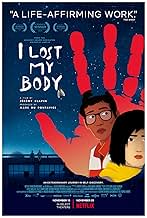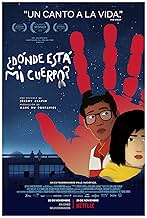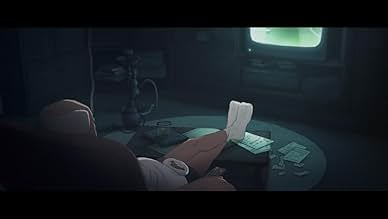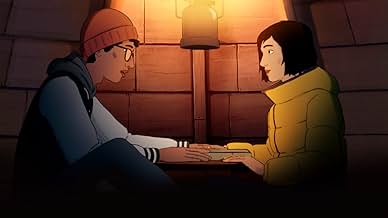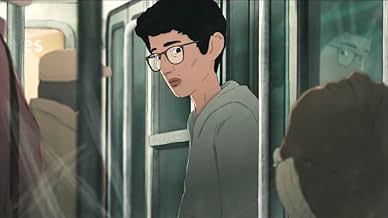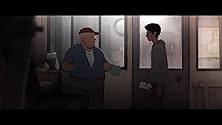La historia de Naoufel, un joven enamorado de Gabrielle. En otra parte de la ciudad, una mano cortada escapa de un laboratorio de disección, decidida a encontrar su cuerpo nuevamente.La historia de Naoufel, un joven enamorado de Gabrielle. En otra parte de la ciudad, una mano cortada escapa de un laboratorio de disección, decidida a encontrar su cuerpo nuevamente.La historia de Naoufel, un joven enamorado de Gabrielle. En otra parte de la ciudad, una mano cortada escapa de un laboratorio de disección, decidida a encontrar su cuerpo nuevamente.
- Nominado a 1 premio Óscar
- 32 premios ganados y 57 nominaciones en total
- Naoufel
- (voz)
- Le père
- (voz)
- La mère
- (voz)
- La bibliothécaire
- (French version)
- (voz)
- (as Maud Le Guénédal)
- La copine de Raouf
- (French version)
- (voz)
- (as Déborah Grall)
- Sandra
- (English version)
- (voz)
Argumento
¿Sabías que…?
- TriviaMarks the first time a feature-length animation has won prestigious Cannes parallel selection, Critics' Week Grand Prize.
- ErroresThe map on the bathroom door mistakenly reads Turkey above Greece whereas the name Greece (as well as the countries above it) is omitted.
- Citas
Naoufel: Do you believe in fate? No, seriously.
Gabrielle: That everything is written in advance? That we follow a trajectory?
Naoufel: Yeah
Gabrielle: And that we can't change anything?
Naoufel: We think that we can, but we can't. It's an illusion. Unless we do... Something completely unpredictable and irrational. It's the only way to conjure the spell for good.
- ConexionesFeatured in 47th Annie Awards (2020)
This is more than a handy pun. Most of the primary elements of creating animation are included in the narrative. It has music--the boy's mother played the cello, and he and a blind man play the piano. The boy also collected audio on a cassette recorder (a device which also serves a critical function in the overcoming of the heroes' obstacles). Also notice the focus in the story on disembodied dialogue (e.g. the pizza delivery scene), which is what voice acting consists of, and on sound effects (e.g. the sound of wind from pressing one's hand to their ear). Besides the promise of a generic romantic coupling, the girl's role here also is in the writing department. She's a librarian and recommends to him a novel, "The World According to Garp," which itself is a piece of multi-layered, self-referential fiction about a writer and writing. Additionally, the boy borrows books about igloos from the library, which provides him with inspiration for his architectural designs. Thus, we have design (architectural and written), a soundtrack and a score. All that's left is to build the visuals of the animation. For that, he becomes a carpenter's apprentice--using, as his employer gives a helping hand, tools, accessories and instruments to transform the material, wood, which comes from the same stuff the paper animators used to draw films on did.
Note that only then does the hand's separate story begin, from an "accident" of carpentry. Film is a process of reanimation; in live action especially, but also, through inspiration or as reference, in animation as well, film captures something alive--something animated--then kills and makes it inanimate as still images before, finally, reanimating what was once captured as the projected (or Netflix streamed, as the case may be) motion picture that the spectator views. Likewise, the hand's individual adventure begins when he is captured by the electric saw; next, the hand lies dead before becoming reanimated as something entirely different from what it once was. In other words, the disembodied hand here is a metaphor for film and, specifically, animated film. It's the film-within-the-film, the hand's journey nested between the outer story of the boy's making of that story, along with the girl as being something of our on-screen surrogate spectator.
Unlike in live action, these drawn compositions don't necessitate a physical camera. This provides a free hand to the perspective of the picture, the theoretical camera's eye, which in turn becomes the spectator's shared vantage point, to be limited only by the filmmakers' imagination. The handling of that camera here is where "I Lost My Body" most excels visually in my estimation. In addition to alternating between color and black-and-white palettes and 2D and 3D computer animation, there's some shifting in perspectives. We and the camera are sometimes like a fly--oblivious, perhaps, to the characters when we're at a distance on a wall, but a nuisance when we swoop in or rest too close upon them. Other times, we share the point of view of this or that character--both what they see in the outside world and, through memories and fantasies, what they imagine with their mind's eye. At one point, we're just a disembodied eyeball resting on a floor. We may even be a reflection in a subway mirror as we witness a hand hiding under a ravioli can scurrying by. (By the way, does anyone else sense a dig at Pixar--specifically "Ratatouille" (2007) with this sequence involving rats, but with other scenes, too, such as floating through the wind (albeit it with an umbrella instead of balloons) between cars, and I can't think of any better reason for the astronaut business here. It would be fitting since, after all, Pixar largely killed traditional animation.)
Even better here is the attempt, which seems specifically more suited to animation because of how it's made, to expand the sensory stimuli by adding texture and a motif of the hand feeling the physical world around it. We experience movies, to paraphrase Charlie Chaplin, as movement, two planes and a suggestion of depth; it's something we've always seen and, later, also heard. Of course, we also feel emotionally and physically in response to the audio-visual experience. Thus, sure, "I Lost My Body" is touching, but, moreover, its tactile focus, hand-in-hand with its self-reflexive framework, almost gives the impression that it's a movie we can feel, to reach out and touch back.
- Cineanalyst
- 2 dic 2019
- Enlace permanente
Selecciones populares
- How long is I Lost My Body?Con tecnología de Alexa
Detalles
- Fecha de lanzamiento
- Países de origen
- Sitios oficiales
- Idioma
- También se conoce como
- I Lost My Body
- Productoras
- Ver más créditos de la compañía en IMDbPro
Taquilla
- Total a nivel mundial
- USD 1,136,431
- Tiempo de ejecución1 hora 21 minutos
- Color
- Mezcla de sonido
- Relación de aspecto
- 2.35 : 1
Contribuir a esta página


![Ver Bande-annonce [OV]](https://m.media-amazon.com/images/M/MV5BMzE5OTZhZDItNTgzYy00NGYwLWJlZjQtZjU0OTI3YjliZThhXkEyXkFqcGdeQXRyYW5zY29kZS13b3JrZmxvdw@@._V1_QL75_UX500_CR0)
![Bande-annonce Teaser [OV]](https://m.media-amazon.com/images/M/MV5BYjU0NzM3ZDctYWYyMS00ZjQyLTlhMDMtZmI0YzdmM2JlNGMxXkEyXkFqcGdeQXRyYW5zY29kZS13b3JrZmxvdw@@._V1_QL75_UX500_CR0)




